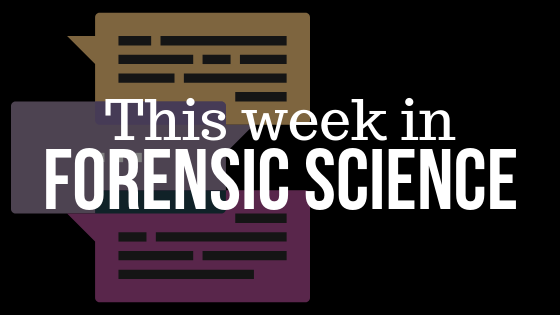No one has hours to scour the papers to keep up with the latest news, so we’ve curated the top news stories in the field of Forensic Science for this week. Here’s what you need to know to get out the door!
Is Ancient DNA Research Revealing New Truths – or Falling Into Old Traps? (The New York Times Magazine – 1/17/2019)
Geneticists have begun using old bones to make sweeping claims about the distant past. But their revisions to the human story are making some scholars of prehistory uneasy.
DNA Results in Two Hours at a Jail? Measure Supported by Tulsa County Would Prepare for New Tech (Tulsa World – 1/19/2019)
- Pending legislation would allow jails to use a relatively new DNA testing method that can deliver results in under two hours, helping law enforcement solve crimes faster.
The process is called Rapid DNA and uses a device about the size of a desktop copier.
Tulsa County is supporting the measure, Senate Bill 184, by Sen. Wayne Shaw, R-Grove.
Podcast Spotlights Mississippi Double Murder – Can New DNA Technology Solve the Cold Case? (CBS News – 1/19/2019)
A man haunted by the unsolved murders of his step-grandmother and her friend made a podcast about the crime — it’s a story that “48 Hours” started covering as a cold case, but turned into something very different thanks to a relentless detective and cutting-edge technology
Coming Soon to a Police Station Near You: The DNA ‘Magic Box’ (The New York Times – 1/21/2019)
With Rapid DNA machines, genetic fingerprinting could become as routine as the old-fashioned kind. But forensic experts see a potential for misuse.
House Supports Morrison’s Bill Providing New Tool to Identify Human Remains (My Wabash Valley – 1/22/2019)
The House of Representatives voted Tuesday in support of State Rep. Alan Morrison’s (R-Brazil) proposal giving coroners one more way to quickly and accurately identify human remains.
Why China is the Brave New World of Editing Human DNA (Bloomberg – 1/22/2019)
As part of its effort to dominate scientific spheres including biotechnology, China has taken the lead in testing uses of Crispr, a tool newly available to researchers enabling them to alter DNA codes simply and inexpensively.
The Ocean is Full of Drifting DNA. The United States News to Collect It, Researchers Say (Science – 1/22/2019)
Scientists at the University of Sheffield studying ancient DNA have created a tool allowing them to more accurately identify ancient Eurasian populations, which can be used to test an individual’s similarity to ancient people who once roamed the earth.
DNA Study Debunks Rudolf Hess Impostor Theory (The Guardian – 1/22/2019)
For years, there were rumours that the prisoner known as Spandau #7 at the Berlin jail was an impostor substituted in to take the place of the deputy Führer of the Third Reich.
But now scientists say analysis of blood samples from Spandau #7 and a living relative of Hess has put an end to the theory. The inmate was Hess after all.
Innocent Man Wrongly Sent to Prison for 33 Years Pitches Lawmakers on ‘Junk Science’ Bill (Richmond Times-Dispatch – 1/23/2019)
It would allow people who claim innocence to petition the Virginia Court of Appeals, arguing that developments in forensic science now clear them, or that they were convicted largely by a forensic science technique or testimony that has since been discredited.
Maryland Bill Proposes Curbing Forensic Genealogy (Forensic Magazine – 1/23/2019)
Forensic genealogy to identify criminal offenders through GEDmatch and related databases would be prohibited in Maryland, according to the intent of a new bill pending in that state’s legislature.
Proponents of the ban point to civil-rights concerns, while opponents of the bill point to the case-breaking potential use of databases through which people voluntarily make genetic information public.
‘We Are Going Backward’: How the Justice System Ignores Science in the Pursuit of Convictions (NBC News – 1/23/2019)
Across the country, forensic techniques found tenuous by independent researchers representing a variety of specialties — including linking indentations found on a victim’s body to a suspect’s teeth — are still being used as evidence to convict people.
And that, critics say, can lead to wrongful convictions.
Solving Old Cases with DNA Technology (witf – 1/23/2019)
Appearing on Smart Talk to discuss DNA forensics and the Mirack case are Craig Stedman, Lancaster County District Attorney, and CeCe Moore, Chief Genetic Genealogist with Parabon Nanolabs, the organization who assisted the Lancaster DA with identifying Christy Mirack’s murderer. Also joining the conversation is Dr. Mitchell Holland, Penn State Associate Professor of Biochemistry and Molecular Biology and a fellow with American Academy of Forensic Sciences.
WOULD YOU LIKE TO SEE MORE ARTICLES LIKE THIS? SUBSCRIBE TO THE ISHI BLOG BELOW!
SUBSCRIBE NOW!


